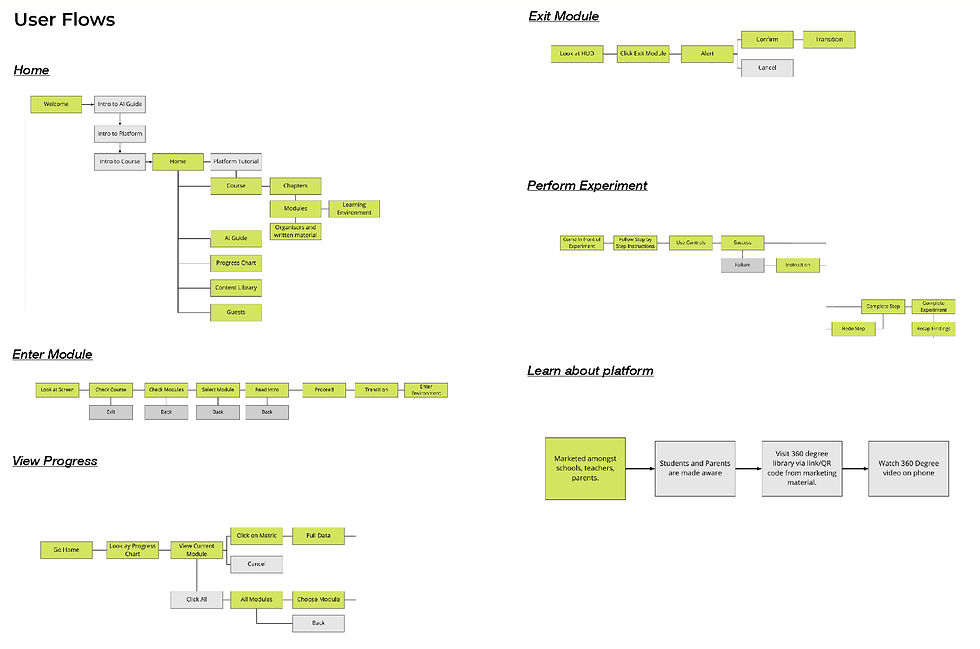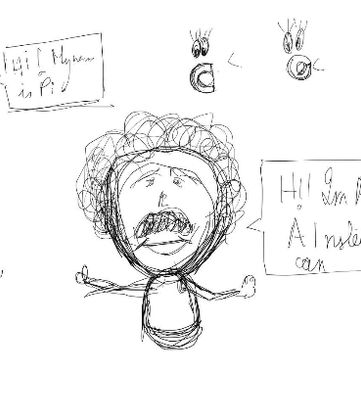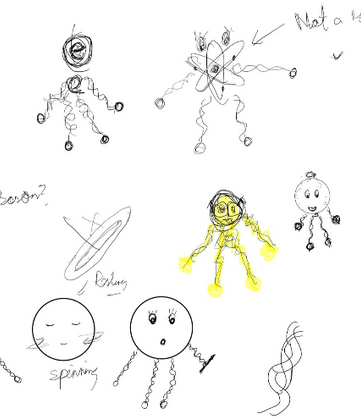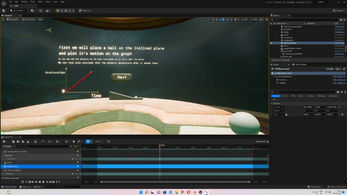

Overview
In traditional educational settings, students, particularly those struggling in STEM (Science, Technology, Engineering, and Mathematics) subjects, often face significant challenges. These challenges can be exacerbated for students with Autism Spectrum Disorder (ASD), who may encounter additional barriers such as sensory sensitivities, social communication difficulties, and a need for structured environments.
Many students, both with and without ASD, may find it challenging to explore their interests in STEM due to distractions, social pressures, or the stigma associated with academic struggles.

The Problem with Classrooms
Image of a Traditional Classroom (Source: Dall-E)
This Project aims to address these challenges by creating a virtual safe space tailored specifically for students struggling in STEM classrooms. To design an inclusive, and comfortable Virtual Learning Environment, which is sensitive to the needs of students belonging on the Autism Spectrum.
The platform will offer a unique set of features designed to provide a supportive and inclusive environment where students can explore and nurture their curiosity in STEM subjects without distractions or stigma.
Objective

Prototype: pupa Classroom
An Individual Project with tons of support
Being a Graduation Project, pupa was a completely conceptualised, designed and developed (prototyped) by me personally.
However it doesn't take away from the fact that I was helped every step of the way. By my mentors who guided me. Peers who were my soundboards. And stakeholders who were willing to give me their precious time!
I also owe a debt of gratitude to my college, Indian Institute of Art and Design and Kingston University for providing me with the opportunity and resources to do this project.

Research phase 1
Immersive Technology & Education

Immersive Reality: An analysis of the technology and it's Pedagogical Possibilities for Education
While discussing educational instruction and the process of teaching, it is not enough to consider disciplinary and pedagogical knowledge separate from technology.
In this paper, (Sabbir 2021) I have discussed various ways in which the technology of Immersive Reality overlaps with Education and Pedagogy. "This overlap is evident with various pedagogical and cognitive theories like situated learning, embodied cognition, constructivism and more play an interesting role. However, immersive content has not been able to fully maximise this technology so far. This is due to the lack of a framework, in which educational content may be turned into immersive content." (Sabbir 2021)
A cookie-cutter approach doesn’t work however, I also there may be a way to maximise the potential of immersive learning- by abstracting mental models into the spatial environment (as shown)
Spatial Arrangement of the Standard Model of Particle Physics (Source: Sabbir 2021)
“Motivation plays a very important, and possibly the most important, part in the learning process. VR can increase engagement, retention, and desire to learn.” (Sushma Sharma, Veative) Veative reports lower Engagement in STEM classrooms. (Sabbir, 2021)
“Educators face difficulty today, due to of the world moving from the Information Age to the Experience Age” (Wadhera, 2016). Students can be resigned and disinterested in the topic (Capps and Crawford, 2013) and don’t seem to understand how the knowledge gained may be used in the real world. (Gee, 2009).
Engagement, interaction and motivation is evidently lower in online classrooms.
I thus wanted to further understand specific problems faced by teachers and students during the covid-19 quarantine, due to distant learning.
Other problems can also be solved by Immersive Technologies-
Lack of 3-dimensional visualisation tools-
A lot of concepts in Physics are largely 3-Dimensional, Everything from the structure of an atom to the 3-dimensional propagation of electro-magnetic waves.
Lack of Experimental Apparatus-
Most schools performed experiments only during offline sessions. This had not only resulted in a lack of Transfer of knowledge in a practical scenario, but has also created a generation of booking, unskilled students.
Lack of Discussion and Interaction-
Online classes usually consist of whiteboard notes. This gets boring and the students are usually not engaged in fruitful discussions. Most students aren’t interested and bunk classes citing network issues etc.
Being a complex issue with many stakeholders, mapping them out was crucial before proceeding further with primary research and user interviews. The core stakeholders of the project are Students and Teachers. Parents can be considered a secondary core stakeholder.
Lack of Engagement and Motivation in STEM classrooms.
Core Team-
Full time on the project/team
Involved-
Regularly providing input or helping to move work forward, but this project is not their sole focus
Informed-
Wants to stay up to date and will provide feedback/input when necessary

Problem Area
As outlined by Punya Mishra (2006) in his paper, “Technological- Pedagogical-Content Knowledge” is a framework for how knowledge about each of these three domains, and understanding about their interplay with each other is important for any teacher for successful instruction.
While discussing educational instruction and the process of teaching, it is not enough to consider disciplinary and pedagogical knowledge separate from technology. Teaching is a complex cognitive skill activity that takes place in a multilayered environment (Leinhardt & Greeno, 1986) and teaching is dependent on access to “highly organized systems of knowledge” (Glaser, 1984).

Key areas of Overlap between Physics Content and Pedagogy. (based on NCERT class 11 Learning Outcomes)
Technology/Pedagogy and Content Overlap
Pedaogogy and Content for physics learning

Emparthy Map
Technology/Pedagogy and Content Overlap

Kannaki Kalita
Grade 11 (Science)
Insights-
-
Dislikes Maths
-
Offline- she likes
-
Physics/ Chemistry - is difficult online. It gets boring. Don’t feel engaged
-
and cannot understand
-
Online tuitions are also difficult.
-
Online classes are mostly copying whiteboard notes

Gayatri Grover
Grade 12 (Science)
Insights-
-
Online classes for 2 months.
-
Online - Network Issues Occur
-
Teachers are just showing videos online.
-
Offline is worse at time when teachers ask you to learn by heart.
-
Videos are prefered, teachers can confuse you.

Yasser Raja
Grade 11 (Science)
Insights-
-
Online class is very messy
-
Teachers can’t manage
-
Most people bunk classes.
-
Only notes dictated.
-
Grasping physics concepts is very difficult online.
-
Prefers one-on-one discussion.
Student Interviews

Gazi N. Ahmed
Professor of Experimental Physics
Insights-
-
23 years career
-
Various Programs- Phd, Advanced, Bachelors
-
In 1998 the focus was on Nuclear Physics
-
Nowadays Material , Fiber Optics, Astrophysics etc are important.
-
Projects-Students do under various student
-
Students can be atoms one by one.
-
Labs are not available online
.jpeg)
Gautam Deka
Physics Teachser
-
Interaction is a problem online.
-
3d concepts like Fleming’s right hand rule cannot be taught online.
-
Concentration is low online.
-
Students mostly prefer videos and graphics.
-
Labs aren’t taught online. However sometimes the students use “O-labs” by Government of India.
-
There are errors in real experiment, but not online.

Smita Pathak
Physics Teachser
. Insights-
-
Video Network Issues
-
Engagement is low.
-
Some students don’t like online
-
As they cannot clear their doubts.
-
They hesitate to ask questions
-
Faces aren’t shown- Now sure if they understand
-
Are students learning or not?
-
Difficult to understand the student’s individual personality
-
Decreased emotional bond or attachment
Teachers Interviews

Student Interview Insights- Card Sorting
Teacher Interview Insights- Card Sorting
Research Phase 2
VR Technology and Special needs Education
Immersive Reality for Students on the Autism Spectrum
Many people on the autism spectrum, living with atypical sensory processing can make it difficult to function effectively within a particular environment. (Marco, 2011)
Autistic students may experience both hypersensitivity (over-responsiveness) and hyposensitivity (under-responsiveness) to a wide range of stimuli. Most people have a combination of both.
Hyposensitivity is also common. This can look like a constant need for movement; difficulty recognizing sensations like hunger, illness or pain; or attraction to loud noises, bright lights and vibrant colors.
VR has shown tremendous potential for students with Autism Spectrum Disorder.
1. it offers structure, visual learning mediation, repetition opportunities, affective engagement and additional control of learning environment. An effective, convenient, supportive and emotionally comfortable area. (Horbova, 2011)
2. including: malleability, manageability, repeatability, modified sensory stimulation, and the ability to apply personalized approaches and enhancement strategies. (Horbova, 2011)
3. Virtual reality (VR), like other computer programs, has proven to provide a particularly conducive environment for people with ASD. (Vera, 2012)
4. Machine learning in education is a form of personalized learning that can used to give each student a personalized educational experience. In these conditions, students focus more on their own education, can follow the most comfortable pace for them, and make independent decisions about what to study.
(Rouhiainen, 2019)
What is Autism Spectrum Disorder? (Source: carmenbpingree.com)
Symptoms of Autism Spectrum Disorder (Source: ceufast.com)

.jpg)
Interview Insights- Special Care Teacher

Interview Insights- Parent who's child in on the Autism Spectrum

Case Studies
O-Labs
O-labs or Online Labs (www.olabs. edu.in) is a website hosted by the Government of India. It is a platform where students are able to conduct experiments online in any STEM subject. The platform consists of 2D simulations of experimental apparatus, along with necessary information required to perform the experiment in real life. As part of the virtual lab initiative, OLabs emulate a one-on-one tutoring system allowing a student to do the experiment anytime and anywhere.
‘Theory’ tab contains instructions for an experiment. Similarly there is
a Procedure, section with animations which help a student gain under-standing of how to perform the same. The ‘Video’ tab shows the video of the experiment as done in a traditional lab. The Simulation can be used to perform the experiment interactively.

Floreo
Floreo’s vision is a world that is open and accessible for every neurodiverse person. They want to create a therapy “metaverse”, a virtual world that is safe for learners, equipping them with skills and tools they can apply in their everyday lives. “We have developed a VR platform that teaches social, behavioral, communication and life skills for individuals with Autism Spectrum Disorder (ASD), ADHD, Anxiety and other neurodiverse conditions.” (Floreo) Floreo’s founder reports his Autistic son’s life changing when he tried on a VR headset. “Vijay wondered how VR’s transformational power could be used to help the lives of kids all around the world--just like it did for his own son. “(StartED.com) Floreo consists of activities which can be shared together by the parent and child.

User Personas
Brainstorming
Ideation Phase 1

Affinity Map
This affinity map was created after completion of the research phase to understand the various aspects of this complex problem to come up with a solution for the user. The four main aspect of my research was the User, the Technology, the Pedagogy and the specific Physics content .
Conceptualising
Ideation Phase 2: Final Conept
Image: pupa Classrrom
• A safe, virtual space to Learn
• Immersive 3D visualization of concepts
• “Learn by Doing” environment for experiments.
• Immersive Directed Narrative (Now)
• Simulations (Future)
• Accessible Design- Universal Design in Education
Final Concept: A Safe Space for Science

Initial Concept Sketches & Diagrams

Concept Map: A Safe Space for Science
Feature List
Immersive Visualisation
3D visualisation of concepts with authentic Environments and Contexts for Situated Learning.
Interactive Experiments
Learning is based on Experiments and (Activities to be conducted by the Student).
Comforting and Safe
Use of comforting space design, comforting ui without flashing lights, loud noises and sudden changes.
Independent learning with Collaborative Features
Primarily for Independent and Personal Learning Collaborative tools for teachers, support staff and peers.
Flexibility
Repeat and revisit experiments and modules. Learn at vour own pace Customisable Environment
Visual/Voice Communication
Assistive Features such as Pictorial Communicators, Speech to Text etc.
Accessibility
With adherence to Principles of Universal Design in Learning (UDL).
Artificial Intelligence
Al and ML based Interest tracking and suggestion of videos, articles and other content accordingly. Animated Pedagogical Agents with conversational AI which support students with their learning.
360 Degree youtube library
Learning is based on Experiments and Activities tp be conducted by the Student.

User Flows

Information Architecture
User Journey

Environment Design


Classroom

Character Design

Learning Module Design
The learning module selected for the prototype was "The Law of Inertia" from the chapter "Motion" from Central Board of Secondary Education's Physics syllabus for grade 11.
The activity for the module was the "balloon in a car" experiment. In this experiment, as the car moves forward, a helium balloon inside will move forward due to inertia, whereas a balloon filled with normal air would move back.
Selected Module

Prototyping- Unreal Engine
Unreal Engine was chosen for the project as it gave enough functionality without too much coding knowledge. However certain aspects of coding were important, to understand how Unreal Engine Compiles various interactions, animations, players. worlds etc.
I had to learn Unreal Engine from scratch as I had no experience in the platform. However through rigorous study I was able to learn how to code using "Procedures" (Shown on the left)
It was also difficult to make the models look similar on Unreal Engine. Elements had to be baked and lighting had to be reworked.


















































































